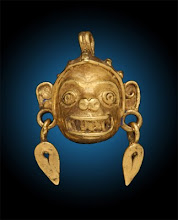I was reading about Lennie Tristano the other day. His students/bandmembers Warne March and Lee Konitz sometimes opened the gigs by playing Bach's two-part inventions arranged for two saxes.
I tried to do a brass arrangement; unfortunately, it's impossible to do for two trumpets, as the pieces span a range over an octave greater than trumpet's range. However, the first one works nicely for trumpet and baritone/euphonium (I choose from the instruments I have and can play). Only the last D of bar 6 is out of range; I transposed the whole phrase (last two beats of bar 6, b-c-d-D) as I wanted to preserve that octave leap.
I guess it can also work for trumpet/trombone or various saxophone combinations.
Here it is: both voices together or separate voices.
Note they are written in C, so if played by a Bb trumpet, they would sound in concert Bb.
Thursday, April 22, 2010
Tuesday, March 23, 2010
JS Bach - Badinerie from Orchestral Suite no.2 in B minor
A stock show-off piece for flautists. It's catchy, fast, and high, and so is also a favorite for trumpet players. I have versions by Alison Balsom, Ole Edvard Antonsen, and Maurice André, who all seem to compete as to who can play it the fastest and the highest. I transcribed it for trumpet from the full score, moving it down from Bmin to Gmin.
Transcription
I will include an Alison Balsom version, which I really like, and also a version by Altamiro Carrilho, who plays it as a choro, dramatically slower and groovier; an approach opposite from everyone else, but I think it works great.
*+*
Transcription
I will include an Alison Balsom version, which I really like, and also a version by Altamiro Carrilho, who plays it as a choro, dramatically slower and groovier; an approach opposite from everyone else, but I think it works great.
Monday, March 15, 2010
Altamiro Carrilho - Chorinhos Didaticos para Flauta
This is from Chorinhos Didaticos para Flauta, a collection of etudes in the choro style by Altamiro Carrilho, a notable Brazilian flutist. Chorinho No.1, trumpet transcription (i.e. transposed down a fifth). I hope to do more as I make my way through the book; might add a backing track in the future.
Thursday, March 11, 2010
Saraiva - Alegria de Campeões
An obscure choro piece, works nicely as an etude. This transcription is in concert pitch, but for trumpet it might be easier to play the notes as written.
Transcription
Hear it:
*
Transcription
Hear it:
Bach's Cello Suites
Jay Lichtmann's most excelent site with a wealth of sheet music for trumpet, trombone, and brass ensembles, including trumpet transcriptions of Bach's first three Unaccompanied Cello Suites @. There's also a full transcription for trombone with a very thorough commentary article at Doug Yeo's site.
I am not nearly advanced enough to play the Cello Suite transcriptions, so instead I am listening to as many versions as I can. So far the interpretation I like the most are Edgar Meyer's double bass transcriptions. He treats the dances as dances, with a steady pulse underneath. Most of the trad cellists play them rubato, one phrase at a time, which makes it difficult for me to follow. Pablo Casals, the presumably greatest-of-them-all godfather of Bach's Cello Suites, really goes overboard with this approach, so it sounds more like a free jazz solo than anything else - try dancing a menuet or allemande to Casals and you'll break your legs.
I also got a pile of other cello versions as well as a transcription for guitar and another one for flute (only the first three, though). Alison Balsom does Sarabande and Gigue from the second suite on her Bach For Trumpet album, and they are OK - she arpeggiates the chords, which must be crazy difficult to play and doesn't sound so good, IMHO.
Now I want to hear the suites on marimba!
I am not nearly advanced enough to play the Cello Suite transcriptions, so instead I am listening to as many versions as I can. So far the interpretation I like the most are Edgar Meyer's double bass transcriptions. He treats the dances as dances, with a steady pulse underneath. Most of the trad cellists play them rubato, one phrase at a time, which makes it difficult for me to follow. Pablo Casals, the presumably greatest-of-them-all godfather of Bach's Cello Suites, really goes overboard with this approach, so it sounds more like a free jazz solo than anything else - try dancing a menuet or allemande to Casals and you'll break your legs.
I also got a pile of other cello versions as well as a transcription for guitar and another one for flute (only the first three, though). Alison Balsom does Sarabande and Gigue from the second suite on her Bach For Trumpet album, and they are OK - she arpeggiates the chords, which must be crazy difficult to play and doesn't sound so good, IMHO.
Now I want to hear the suites on marimba!
Music notation

I always wondered who is to blame for the modern music notation (a rather imperfect and awkward system, IMO) - it's Guido d'Arezzo, also the father of solmization/solfège. Here's a biographical article from Catholic Encyclopedia and a pdf article specifically on his musical work. Perhaps his achievements are easier to see in context: Gregorian chant notation that was used before 1000AD, AKA neumatic notation.
Mission statement
This is a place to share music-related stuff: links, my transcriptions, musings on playing the instrument, and the like.
Subscribe to:
Comments (Atom)

